Abstract
In a previous study we demonstrated that lipopolysaccharide failed to elicit nonspecific resistance in C3H/He lipopolysaccharide low-responder mice against Klebsiella infection in contrast to its activity in a closely related histocompatible high-responder subline, C3HeB/Fe. Complete restoration of lipopolysaccharide-induced protection against 10(5) Klebsiella was obtained in the present study by transferring bone marrow from high-responder mice to the highly deficient C3H/He mice. The ability of C3H/He mice to clear and destroy bacteria in 5 h was also transferred by C3HeB/Fe marrow cells. In contrast, when high-responder C3HeB/Fe mice were reconstituted with low-responder bone marrow, the clearance and destruction of K. pneumoniae were similar to what is observed in the high-responder strain, but survival was only temporary. Collectively, our data show that the failure of C3H/He mice to respond to lipopolysaccharide with nonspecific immunity is due to a defect in two types of bone-marrow-derived cells--radioresistant and radiosensitive.
Full text
PDF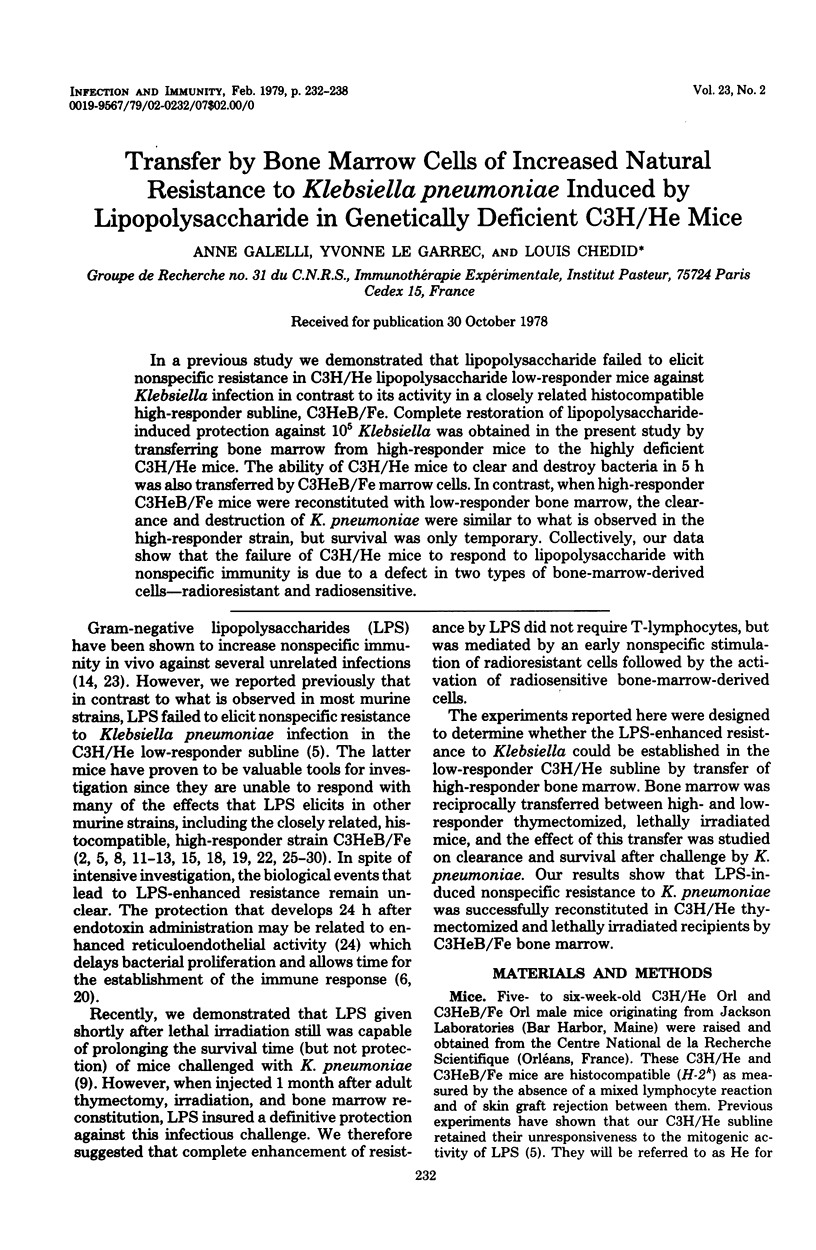
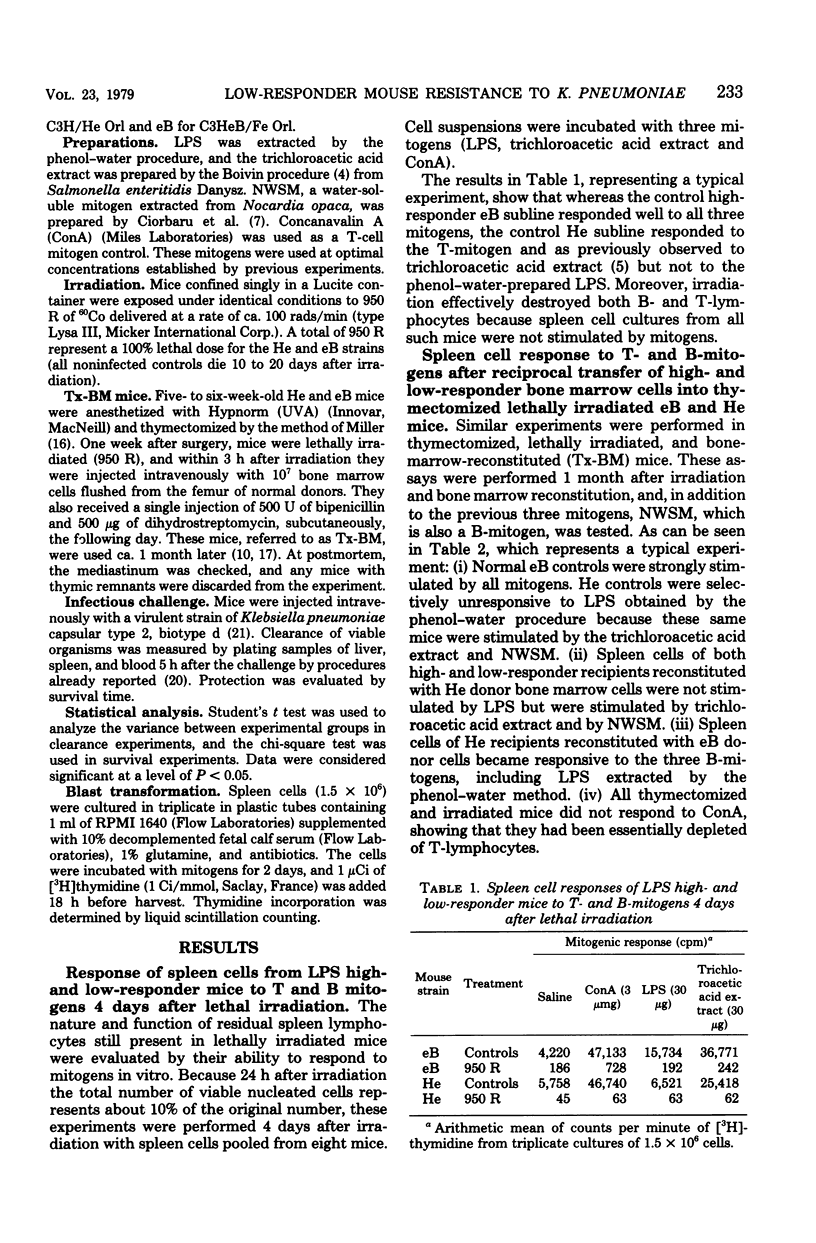
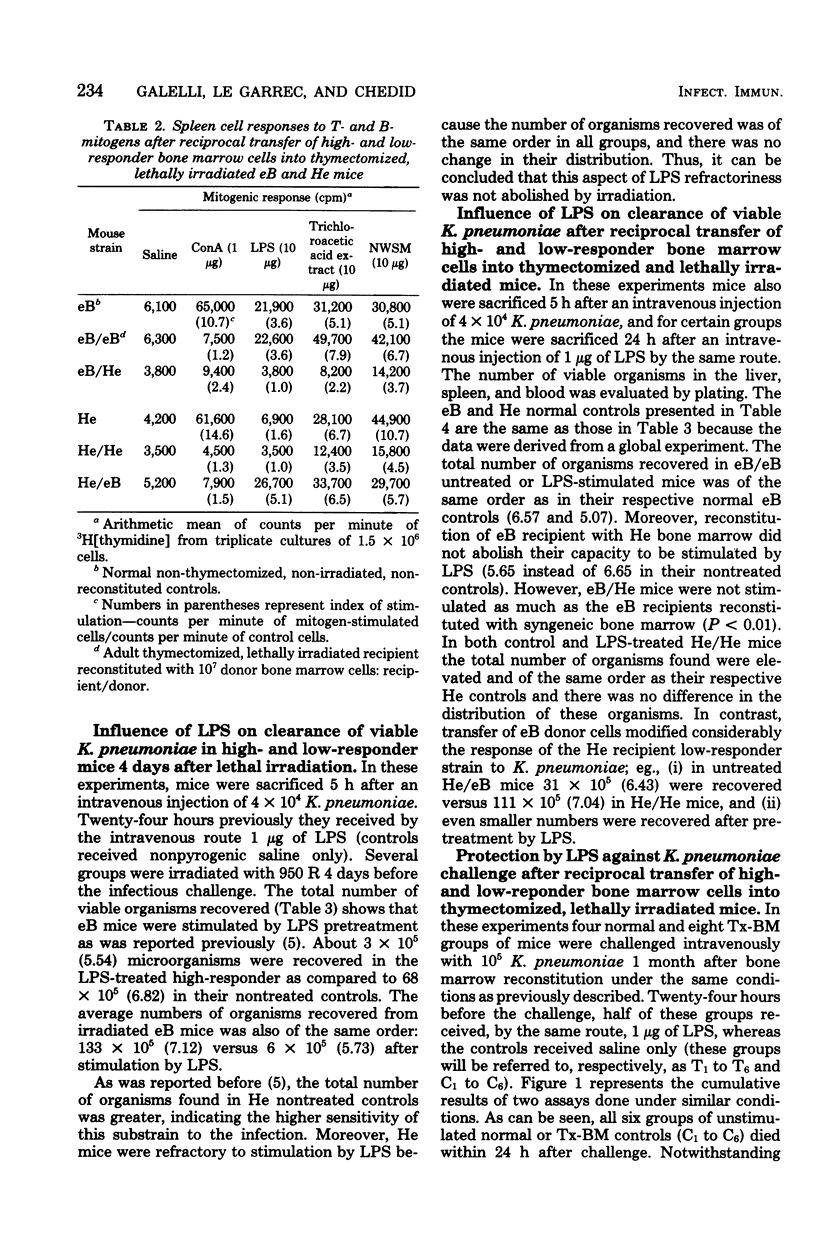
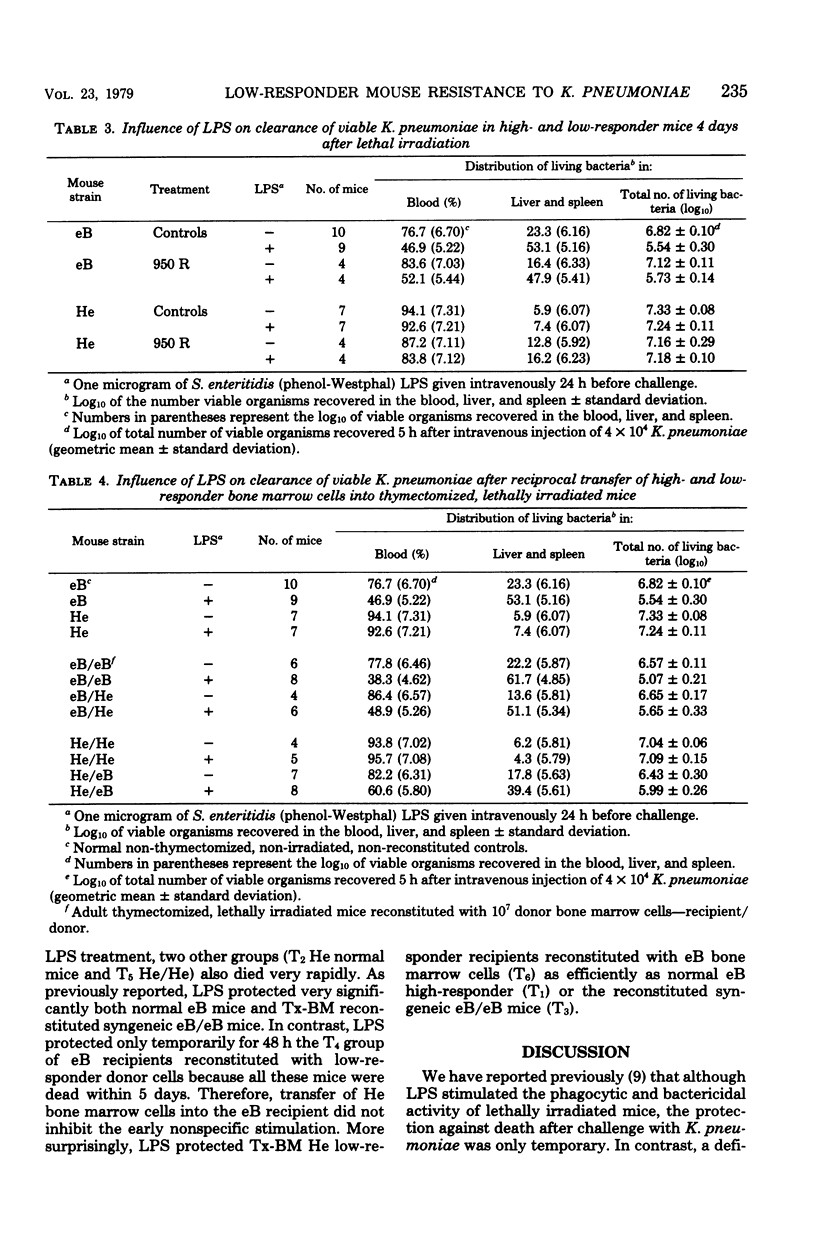
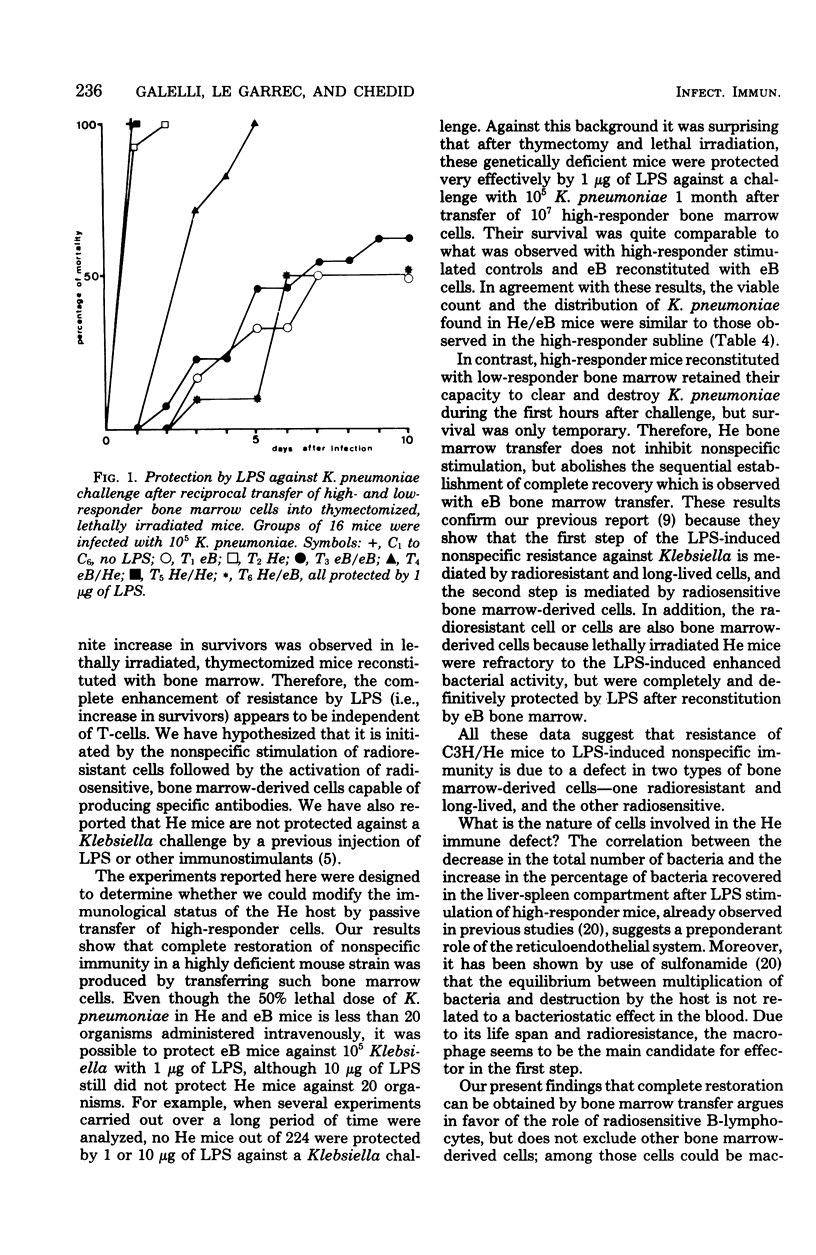
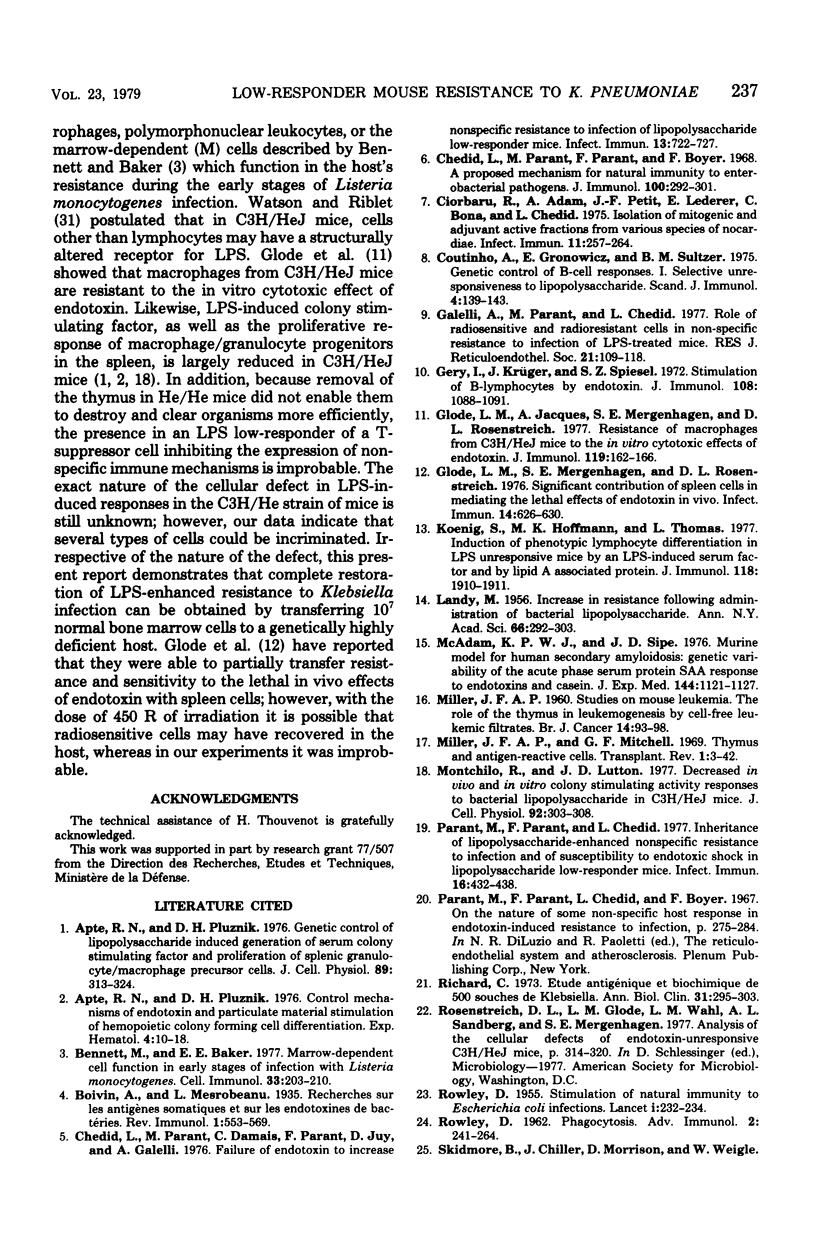
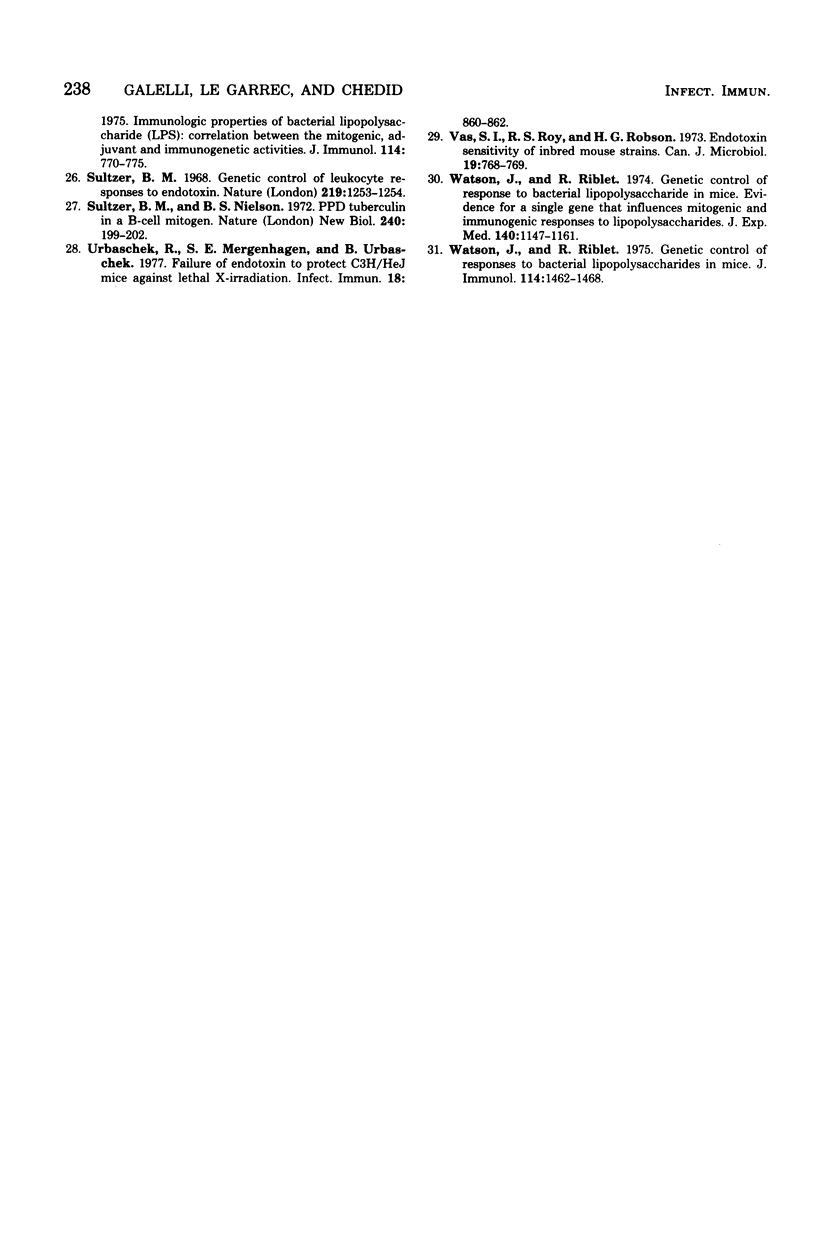
Selected References
These references are in PubMed. This may not be the complete list of references from this article.
- Apte R. N., Pluznik D. H. Control mechanisms of endotoxin and particulate material stimulation of hemopoietic colony forming cell differentiation. Exp Hematol. 1976 Jan;4(1):10–18. [PubMed] [Google Scholar]
- Apte R. N., Pluznik D. H. Genetic control of lipopolysaccharide induced generation of serum colony stimulating factor and proliferation of splenic granulocyte/macrophage precursor cells. J Cell Physiol. 1976 Oct;89(2):313–323. doi: 10.1002/jcp.1040890214. [DOI] [PubMed] [Google Scholar]
- Bennett M., Baker E. E. Marrow-dependent cell function in early stages of infection with Listeria monocytogenes. Cell Immunol. 1977 Sep;33(1):203–210. doi: 10.1016/0008-8749(77)90147-2. [DOI] [PubMed] [Google Scholar]
- Chedid L., Parant M., Damais C., Parant F., Juy D., Galelli A. Failure of endotoxin to increase nonspecific resistance to infection of lipopolysaccharide low-responder mice. Infect Immun. 1976 Mar;13(3):722–727. doi: 10.1128/iai.13.3.722-727.1976. [DOI] [PMC free article] [PubMed] [Google Scholar]
- Chedid L., Parant M., Parant F., Boyer F. A proposed mechanism for natural immunity to enterobacterial pathogens. J Immunol. 1968 Feb;100(2):292–306. [PubMed] [Google Scholar]
- Ciorbaru R., Adam A., Petit J. F., Lederer E., Bona C., Chedid L. Isolation of mitogenic and adjuvant active fractions from various species of Nocardiae. Infect Immun. 1975 Feb;11(2):257–264. doi: 10.1128/iai.11.2.257-264.1975. [DOI] [PMC free article] [PubMed] [Google Scholar]
- Coutinho A., Gronowicz E., Sultzer B. M. Genetic control of B-cell responses. I. Selective unresponsiveness to lipopolysaccharide. Scand J Immunol. 1975;4(2):139–143. doi: 10.1111/j.1365-3083.1975.tb02610.x. [DOI] [PubMed] [Google Scholar]
- Galelli A., Parant M., Chedid L. Role of radiosensitive and radioresistant cells in nonspecific resistance to infection of LPS-treated mice. J Reticuloendothel Soc. 1977 Feb;21(2):109–118. [PubMed] [Google Scholar]
- Gery I., Krüger J., Spiesel S. Z. Stimulation of B-lymphocytes by endotoxin. Reactions of thymus-deprived mice and karyotypic analysis of dividing cells in mice bearing T 6 T 6 thymus grafts. J Immunol. 1972 Apr;108(4):1088–1091. [PubMed] [Google Scholar]
- Glode L. M., Jacques A., Mergenhagen S. E., Rosenstreich D. L. Resistance of macrophages from C3H/HeJ mice to the in vitro cytotoxic effects of endotoxin. J Immunol. 1977 Jul;119(1):162–166. [PubMed] [Google Scholar]
- Glode L. M., Mergenhagen S. E., Rosenstreich D. L. Significant contribution of spleen cells in mediating the lethal effects of endotoxin in vivo. Infect Immun. 1976 Sep;14(3):626–630. doi: 10.1128/iai.14.3.626-630.1976. [DOI] [PMC free article] [PubMed] [Google Scholar]
- Koenig S., Hoffmann M. K., Thomas L. Induction of phenotypic lymphocyte differentiation in LPS unresponsive mice by an LPS-induced serum factor and by lipid A-associated protein. J Immunol. 1977 May;118(5):1910–1911. [PubMed] [Google Scholar]
- MILLER J. F. Studies on mouse leukaemia. The role of the thymus in leukaemogenesis by cell-free leukaemic filtrates. Br J Cancer. 1960 Mar;14:93–98. doi: 10.1038/bjc.1960.11. [DOI] [PMC free article] [PubMed] [Google Scholar]
- McAdam K. P., Sipe J. D. Murine model for human secondary amyloidosis: genetic variability of the acute-phase serum protein SAA response to endotoxins and casein. J Exp Med. 1976 Oct 1;144(4):1121–1127. doi: 10.1084/jem.144.4.1121. [DOI] [PMC free article] [PubMed] [Google Scholar]
- Miller J. F., Mitchell G. F. Thymus and antigen-reactive cells. Transplant Rev. 1969;1:3–42. doi: 10.1111/j.1600-065x.1969.tb00135.x. [DOI] [PubMed] [Google Scholar]
- Parant M., Parant F., Chedid L. Inheritance of lipopolysaccharide-enhanced nonspecific resistance to infection and of susceptibility to endotoxic shock in lipopolysaccharide low-responder mice. Infect Immun. 1977 May;16(2):432–438. doi: 10.1128/iai.16.2.432-438.1977. [DOI] [PMC free article] [PubMed] [Google Scholar]
- ROWLEY D. Stimulation of natural immunity to Escherichia coli infection: observations on mice. Lancet. 1955 Jan 29;268(6857):232–234. doi: 10.1016/s0140-6736(55)90163-x. [DOI] [PubMed] [Google Scholar]
- Richard C. Etude antigénique et biochimique de 500 souches de Klebsiella. Ann Biol Clin (Paris) 1973;31(4):295–303. [PubMed] [Google Scholar]
- Russo M., Lutton J. D. Decreased in vivo and in vitro colony stimulating activity responses to bacterial lipopolysaccharide in C3H/HeJ mice. J Cell Physiol. 1977 Aug;92(2):303–307. doi: 10.1002/jcp.1040920219. [DOI] [PubMed] [Google Scholar]
- Sultzer B. M. Genetic control of leucocyte responses to endotoxin. Nature. 1968 Sep 21;219(5160):1253–1254. doi: 10.1038/2191253a0. [DOI] [PubMed] [Google Scholar]
- Vas S. I., Roy R. S., Robson H. G. Endotoxin sensitivity of inbred mouse strains. Can J Microbiol. 1973 Jul;19(7):767–769. doi: 10.1139/m73-125. [DOI] [PubMed] [Google Scholar]
- Watson J., Riblet R. Genetic control of responses to bacterial lipopolysaccharides in mice. I. Evidence for a single gene that influences mitogenic and immunogenic respones to lipopolysaccharides. J Exp Med. 1974 Nov 1;140(5):1147–1161. doi: 10.1084/jem.140.5.1147. [DOI] [PMC free article] [PubMed] [Google Scholar]
- Watson J., Riblet R. Genetic control of responses to bacterial lipopolysaccharides in mice. II. A gene that influences a membrane component involved in the activation of bone marrow-derived lymphocytes by lipipolysaccharides. J Immunol. 1975 May;114(5):1462–1468. [PubMed] [Google Scholar]


